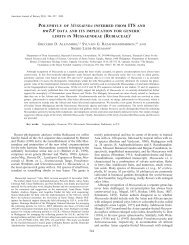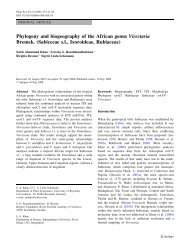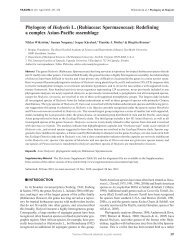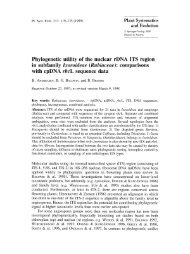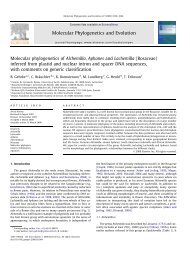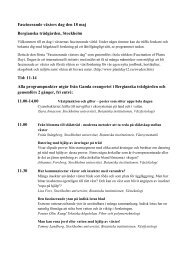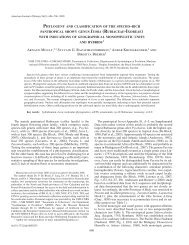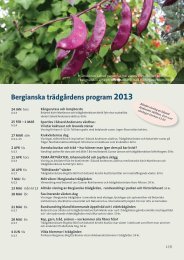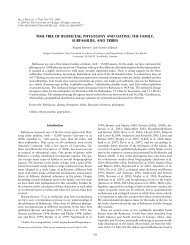Razafimandimbison and Bremer 2011
Razafimandimbison and Bremer 2011
Razafimandimbison and Bremer 2011
Create successful ePaper yourself
Turn your PDF publications into a flip-book with our unique Google optimized e-Paper software.
Nomenclatural changes <strong>and</strong> taxonomic notes in the tribe Morindeae (Rubiaceae)<br />
73. Gynochthodes wallichii (Kurz)<br />
Razafim. & B.<strong>Bremer</strong>, comb. nov.<br />
BASIONYM. — Morinda wallichii Kurz, Journal of the<br />
Asiatic Society of Bengal, Part 2, Natural History 41: 313<br />
(1872). — Type: Herb. Kurz, Tenasserim s.n. (holo-,<br />
CAL).<br />
NEW NAMES<br />
1. Gynochthodes alej<strong>and</strong>roi<br />
Razafim. & B.<strong>Bremer</strong>, nom. nov.<br />
REPLACED NAME. — Morinda philippinensis Elmer,<br />
Leafl ets of Philippine Botany 3: 1044 (1911). — Type:<br />
Philippines, Capiz Prov., Magallanes (Mt. Giting-giting),<br />
Sibuan Isl<strong>and</strong>, V.1910, A. D. E. Elmer 12460 (holo-, A!;<br />
iso-, L!, NY!; US!).<br />
REMARKS<br />
The specific epithet “philippinensis” cannot be used<br />
in combination with Gynochthodes, as it would be<br />
a later homonym of Gynochthodes philippinensis<br />
(Elmer) Merr. The replacement name alej<strong>and</strong>roi<br />
refers to Dr. Grecebio J. Alej<strong>and</strong>ro, who has a good<br />
knowledge of the Philippian Rubiaceae.<br />
2. Gynochthodes ridsdalei<br />
Razafim. & B.<strong>Bremer</strong>, nom. nov.<br />
REPLACED NAME. — Morinda reticulata Gamble, Bulletin<br />
of Miscellaneous Information, Royal Botanic Gardens, Kew<br />
248 (1920). — Type: India (south), evergreen forests of<br />
Travancore, at Merchiston, 600 m alt., IV.1895, Bourdillon<br />
591 (lecto-, K, designated here).<br />
REMARKS<br />
Morinda reticulata Gamble is an illegitimate name, as<br />
it is a later homonym of Morinda reticulata Benth.,<br />
which has priority over the former. <strong>Razafim<strong>and</strong>imbison</strong><br />
et al. (2009) confirmed that the Australian<br />
Morinda reticulata Benth. belongs to Coelospermum,<br />
consistent with Baillon (1879) who already made<br />
the new combination Coelospermum decipiens Baill.<br />
The specific epithet “reticulata” cannot be used in<br />
combination with Gynochthodes, as it would be a<br />
later homonym of Gynochthodes reticulata (Valeton)<br />
Razafim. & B.<strong>Bremer</strong>. The replacement name ridsdalei<br />
refers to Dr. Colin Ridsdale, who has a great<br />
knowledge of the tropical Asian Rubiaceae. Gamble<br />
(1920) listed two specimens, Bourdillon 591 <strong>and</strong><br />
M. Rama Row 1281, when describing his Morinda<br />
reticulata. We chose Bourdillon 591 as lectotype.<br />
3. Gynochthodes wongii<br />
Razafim. & B.<strong>Bremer</strong>, nom. nov.<br />
REPLACED NAME. — Morinda coriacea Merr., Philippine<br />
Journal of Science 17: 435 (1920, publ. 1921). — Type:<br />
Mindanao (Surigao), Ramos <strong>and</strong> Pascasio B.S. 34439<br />
(holo-, A!; US!).<br />
REMARKS<br />
The specific epithet “coriacea” cannot be used in<br />
combination with Gynochthodes, as it would be a<br />
later homonym of Gynochthodes coriacea Blume, the<br />
type of Gynochthodes. The replacement name wongii<br />
refers to Professor Khoon Meng Wong (Malaysia),<br />
who has a great knowledge of the Southeast Asian<br />
Rubiaceae.<br />
Genus Morinda L.<br />
Species plantarum: 176 (1753). — Type: Morinda royoc<br />
L. (lecto-, designated by Hitchcock: 132 [1929]).<br />
Rojoc Adans., Famille des Plantes 2: 246 (1763).<br />
Appunettia Good, Journal of Botany 64 (Supplement 2):<br />
30 (1926). — Type: Appunettia angolensis Good.<br />
Sarcopygme Setch. & Christoph., Occasional Papers of<br />
Bernice Pauahi Bishop Museum of Polynesian Ethnology<br />
<strong>and</strong> Natural History 11: 4 (1935), syn. nov. — Type:<br />
Sarcopygme pacifica (Reinecke) Setch. & Christoph.<br />
DESCRIPTION<br />
Small trees or shrubs, rarely lianas. Leaves petiolate<br />
(rarely subsessile), chartaceous to coriaceous, glabrous.<br />
Inflorescences mostly leaf-opposed (modified<br />
terminal inflorescences), sometimes axillary<br />
with heads arranged into secondarily compound<br />
inflorescences, composed of 1 to 3 heads, sometimes<br />
axillary with heads arranged into secondarily<br />
compound inflorescences, pedunculate (rarely<br />
sessile), branched. Flowers bisexual; corolla tubes<br />
ADANSONIA, sér. 3 • <strong>2011</strong> • 33 (2)<br />
297



